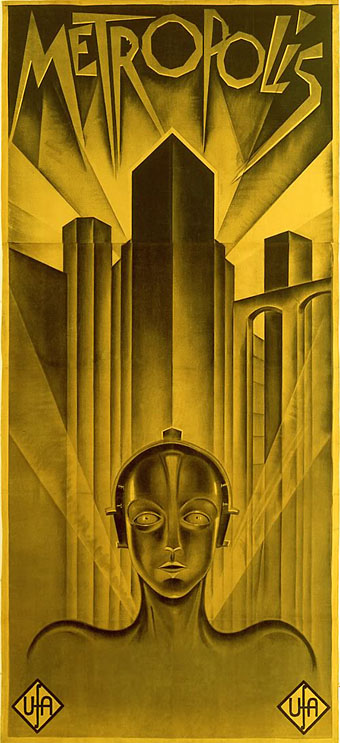Fritz Lang’s masterpiece via some of its posters, all from 1927.
This site is a great source of information about the film.

Designer: Heinz Schulz-Neudamm.
As of 2005, the world’s most expensive film poster, selling for $690,000.
A journal by artist and designer John Coulthart.
Illustrators
Fritz Lang’s masterpiece via some of its posters, all from 1927.
This site is a great source of information about the film.

Designer: Heinz Schulz-Neudamm.
As of 2005, the world’s most expensive film poster, selling for $690,000.
The Treasures of Satan by Jean Delville (1894).
Some more favourite paintings today. Jean Delville produced a splendidly strange portrayal of Satan as an undersea monarch lording it over a sprawl of intoxicated, naked figures. When Savoy Books decided to put together the definitive version of David Lindsay’s equally strange fantasy novel, A Voyage to Arcturus, I felt this was the only painting adequate to the task of filling out the cover. That was in 2002; a year later Gollancz used the same painting on the cover of their Fantasy Masterworks paperback edition of the book. Lindsay’s book has been plagued by bad cover art for years so we managed to raise the bar for future editions. Delville was one of the great painters of the Symbolist school, all his work is worth looking at.
There are numerous representations of Lucifer but Franz Stuck’s is especially striking and apparently caused viewers to cross themselves before it when it was first exhibited.
Gustave Doré’s tumbling figure is from his illustrated edition of Paradise Lost, a book full of armour-clad, spiky-winged angels. Some of those wings have even found their way into my work via the miracle of Photoshop.
Lucifer by Franz Stuck (1890).
Paradise Lost by Gustave Doré (1866).
Elsewhere on { feuilleton }
• The etching and engraving archive
Previously on { feuilleton }
• The art of Thomas Häfner, 1928–1985
Mrs Amworth.
Another great artist of the macabre and supernatural, Virgil Finlay was the one of the most talented and imaginative illustrators of his generation. Unlike older contemporaries such as Joseph Leyendecker, who became wealthy producing elegant yet often bland advertising art, much of Finlay’s best work was for pulp magazines like Weird Tales and Amazing Stories which paid a pittance and printed his finely-hatched scratchboard drawings on the cheapest paper. The advantages to this work, such as they were, came in the access to a huge and appreciative audience, and the chance to provide the first illustrations for what would turn out to be classic genre stories. Finlay illustrated a number of HP Lovecraft’s tales and received the highest praise from the author in doing so. His illustration for Lovecraft’s The Thing on the Doorstep (below) contains a slight nod to Harry Clarke’s Valdemar picture (see previous post) with its distant, highlighted doorway, a detail that Clarke himself borrowed from the celebrated Las Meninas by Velázquez.
Therionweb has five galleries of Finlay’s pictures and Bud Plant again has a brief biography.
Abercrombie Station.
The Thing on the Doorstep.
Six and Ten.
Elsewhere on { feuilleton }
• The illustrators archive
The Masque of the Red Death.
Halloween approaches so let’s consider the finest illustrator of Edgar Allan Poe’s stories, Irish artist Harry Clarke. Aubrey Beardsley once declared “I am grotesque or I am nothing” yet even his grotesquery—which could be considerable—struggled to do justice to Poe. Clarke, the best of the post-Beardsley illustrators, found a perfect match in the Boston writer’s Tales of Mystery and Imagination, his edition being published by Harrap in 1919. He could decorate fairy tales with the best of the great Edwardian book illustrators but a flair for the morbid blossomed when he found Poe. Only his later masterpiece, Goethe’s Faust, improved on the dark splendour of these drawings. “Never before have these marvellous tales been visually interpreted with such flesh-creeping, brain-tainting illusions of horror, terror and the unspeakable” wrote a critic in The Studio.
Lots more pictures at Grandma’s Graphics (although none of the colour plates, unfortunately) including many of the Faust drawings. Wikipedia has photos of some of Clarke’s incredible stained-glass windows, as does Bud Plant’s biography page.
Ligeia.
The Facts in the Case of M. Valdemar.
Elsewhere on { feuilleton }
• The illustrators archive
Continuing the cover art theme, here’s a whole gallery of covers devoted to one book only, HG Wells’ The War of the Worlds, from 1898 to the present. Once again it’s fascinating to see how styles evolve and how different artists and designers approach the task of providing art for the same book. The most common approach with this particular novel has evidently been to depict the tripod machines laying waste to the Home Counties. The samples here follow the pattern: the uncredited 1967 Penguin edition above was the one I read originally (I still have a copy); the other is a cover by Philippe Druillet from 1973 showing a particularly heavy-footed and tentacular Martian vehicle. The site also includes some great interior illustrations.
Elsewhere on { feuilleton }
• The book covers archive